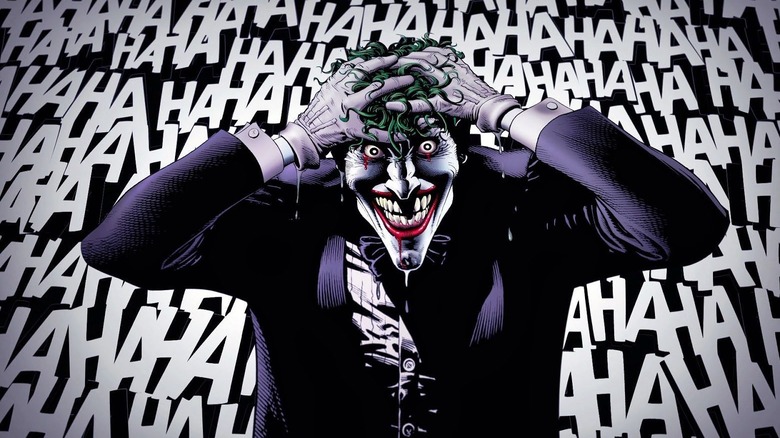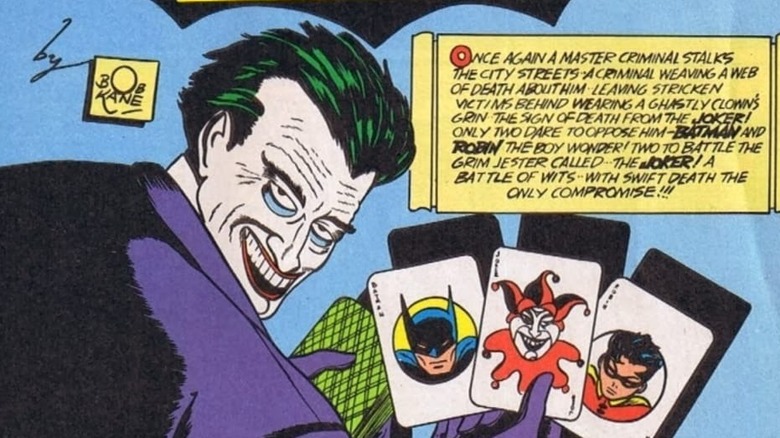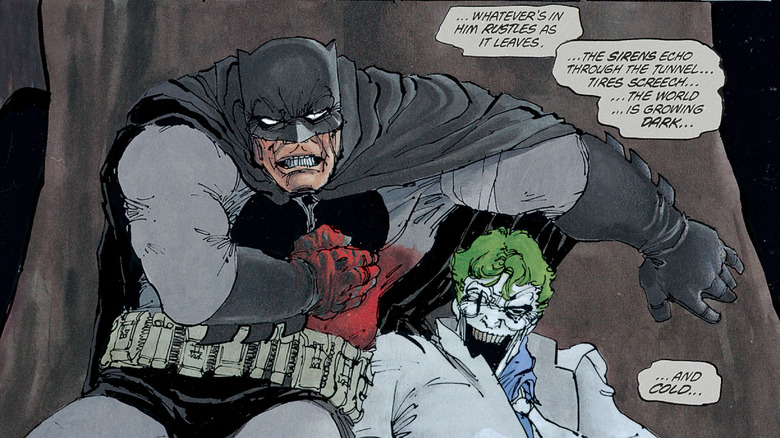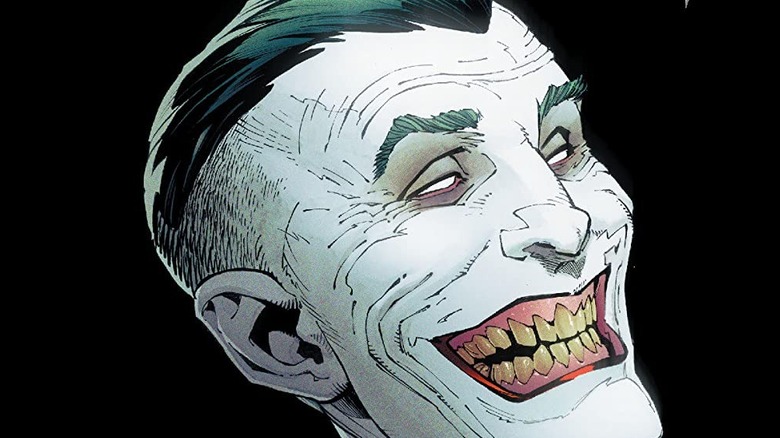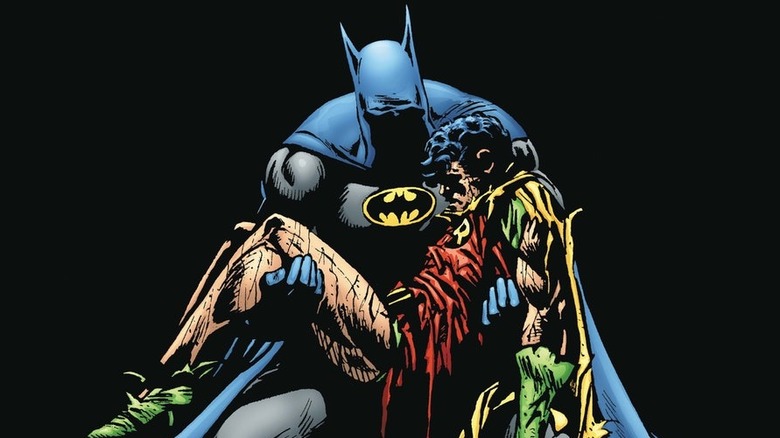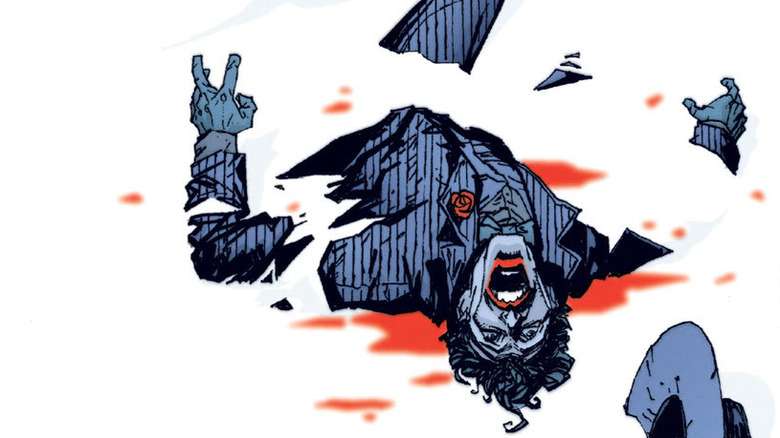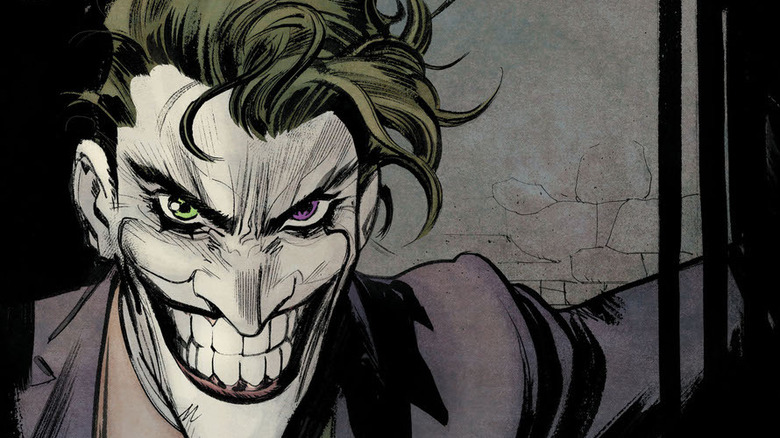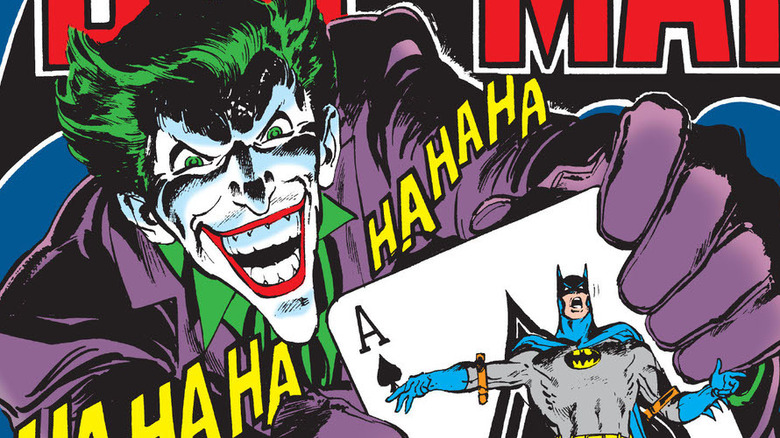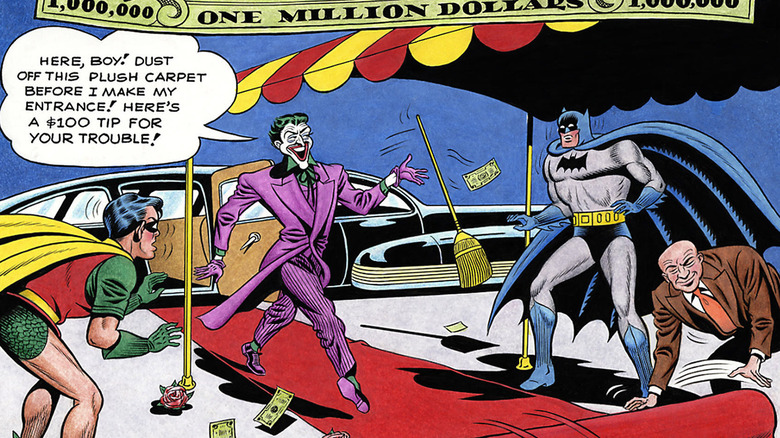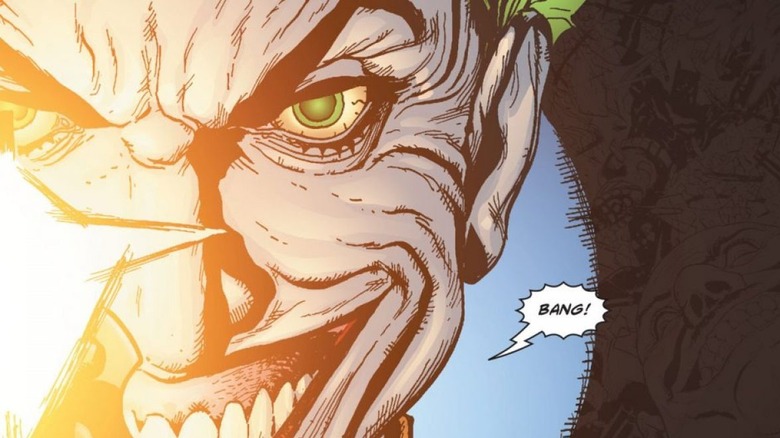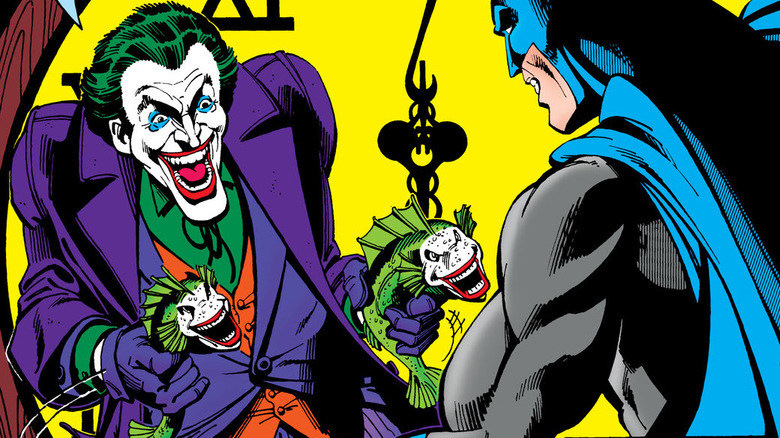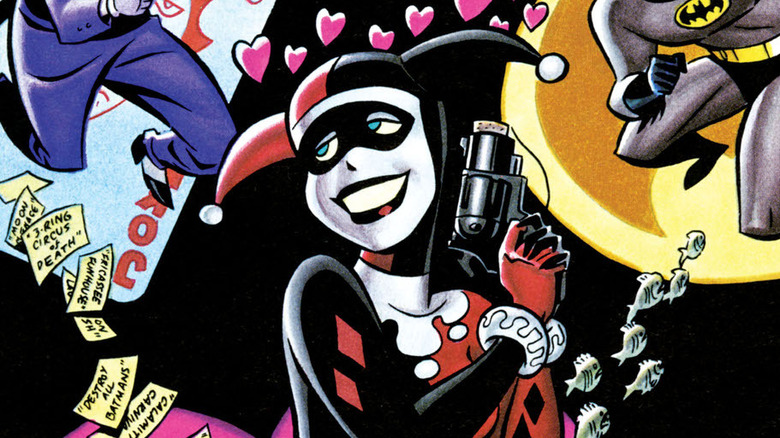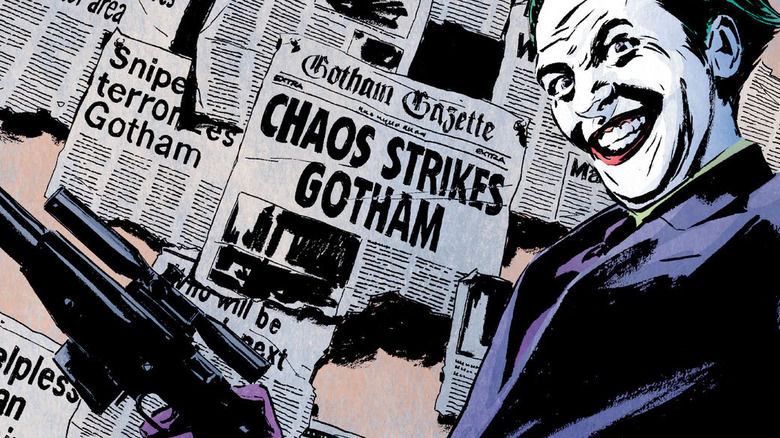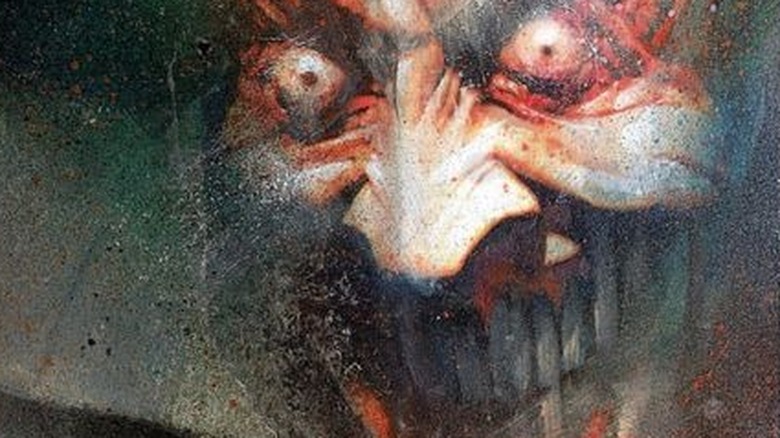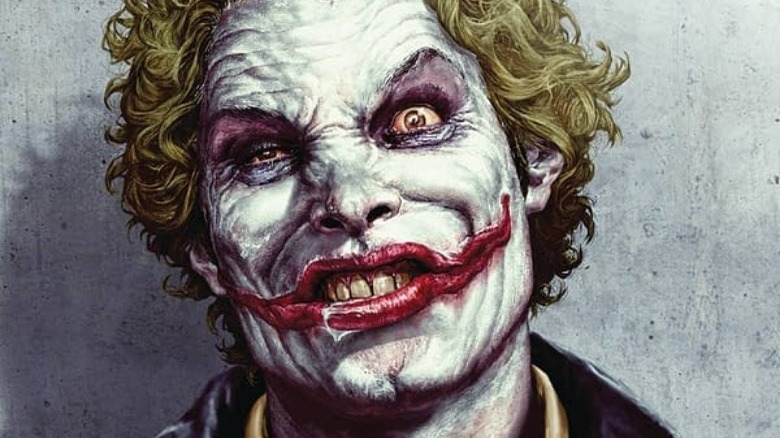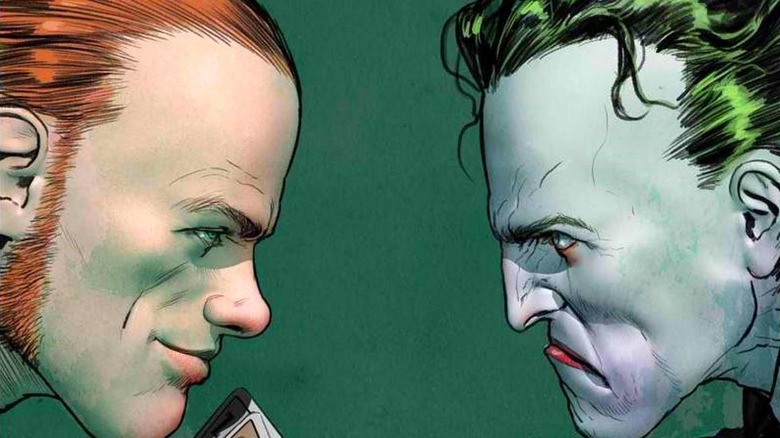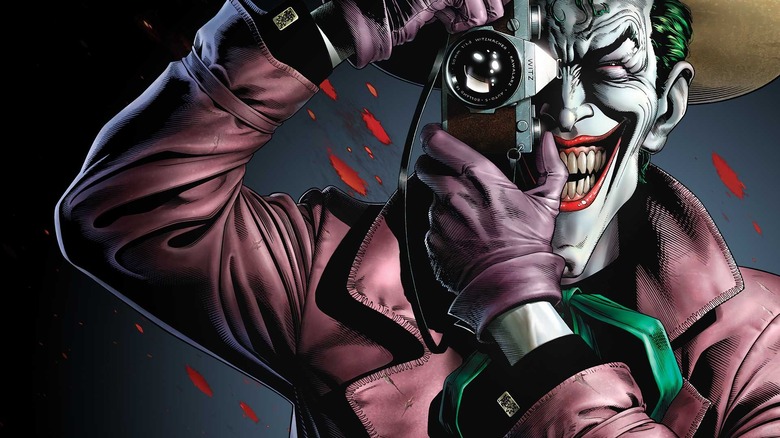The 16 Best Joker Comics You Need To Read
It's hard to believe that the Joker has been around for over 80 years. Since the character's inception, he's become one of the most iconic villains in all of media, and has proved compelling enough to captivate audiences in stories that don't even feature his arch nemesis, Batman. "The Joker is so weird his very presence virtually assures an unusual story," wrote former DC Comics senior editor and director of development Mike Gold in his forward for the 1988 collection "The Greatest Joker Stories Ever Told."
Like the Dark Knight, part of the Joker's eight-decade legacy is the character's malleability. Over the years, writers and artists have shared their own interpretations of the character, resulting in a litany of fantastic stories. Whereas Batman can be everything from a gun-toting vigilante driving a mundane red coupe to a symbol of camp excess to a grizzled avenger of the night, the Joker has been depicted as a master of disguise, an extravagant prankster, a cold-blooded mass murderer, an agent of chaos, and a tragically disturbed outcast. These 16 comics are some of the best he has ever appeared in.
Batman #1 (1940)
The Joker's original appearance came in the first issue of Batman's eponymous comic. As conceived by Batman creators Bill Kane and Bob Finger and artist Jerry Robinson, the Joker's appearance was inspired by German actor Conrad Veidt's visage in the 1928 silent film "The Man Who Laughs," while his flamboyant nature echoed the rogue's gallery of Batman's contemporary Dick Tracy.
In the character's debut story, simply titled "The Joker," the villain commits a series of daring robberies and murders that confound Gotham's police. Even though it's early, many of the character's hallmarks can already be found here, particularly his use of a poison gas that leaves his victims with a disturbing rictus grin.
Fans of "The Dark Knight" will see similarities to "Batman" #1 in both the film's story and it's characterization of the Joker. In the comic, the Joker's crime spree starts when uses the media to threaten the city's populace and foretells of the mayhem to come. He also runs afoul of Gotham's gangsters, breaks into a police station to poison a high-ranking judge, and disguises himself as a policeman. Incidentally, these parallels turned out to be completely coincidental.
The Dark Knight Returns
Frank Miller's Reagan-era masterpiece "The Dark Knight Returns" is quite possibly the most critically-acclaimed Batman comic of all time; it's almost certainly one of the most influential. Although the Joker only plays a supporting role in this brilliant deconstruction of the Caped Crusader, Miller's ink-stained fingerprints have been felt on the character ever since. As comics scribe Grant Morrison put it in his book "Supergods," Miller "added a camp and decadent Weimar-era menace to the Joker, bringing a twisted hypersexuality and feral horror to the crime clown's arsenal of personal defects."
"The Dark Knight Returns" is the comic that definitely answers the question, "Why doesn't Batman just kill the Joker?" In the series' third issue, Batman and the Joker have a gruesome grudge match inside a carnival's Tunnel of Love (the metaphor is not subtle), where Batman brings the Joker to the brink of death. The Joker mocks his adversary's cowardice by breaking his own neck, laughing as he does so. Devoted readers may be recognize a reference to the comic in Todd Phillips' "Joker"– as in the book, the Joker in the film appears on a late night talk show and murders its host (a sex expert even appears as the other guest).
Batman: Endgame
"Endgame" is writer Scott Snyder and artist Greg Capullo's take on a final confrontation between Batman and the Joker, a fiery crescendo that threads together multiple plotlines from their tenure on the title. It's a dense and wild read that may not be for those less well-versed in recent Batman lore, but "Endgame" is a thrill ride nonetheless. This action-packed comic is overflowing with plot twists, pseudo-science, armchair psychoanalysis, feints toward the supernatural, and ultraviolence. Commissioner Gordon takes an ax to the chest, Alfred gets his hand chopped off, and the Joker burns off half of Batman's face and stabs him in the eye with a razor-sharp playing card.
The story kicks off with Batman facing down not just Superman but the entire Justice League in a mechanized super-suit. Batman's skirmish with his teammates is the result of infection by an airborne "Joker virus" that quickly spreads to the entire city, turning Gotham's citizens into a zombie horde. Things only get wilder from there — you won't want to miss its shocking finale.
A Death in the Family
The second most infamous Joker story is undoubtedly "A Death in the Family," in which the villain murders the second Robin, Jason Todd. The plot of "Batman: A Death in the Family" is fairly ludicrous (the Joker steals a nuclear weapon and is granted the title of Iranian ambassador to the United Nations at the behest of Ayatollah Khomeini — yes, really), but the circumstances surrounding the story are fascinating.
Todd, a petty street criminal turned crime fighter with a propensity for violent outbursts, was a divisive figure among Batman fans. DC Comics was unsure what to do about him, so they set up a hotline that readers could call to decide if Robin should live or die. Jason's fate was sealed by an incredibly narrow margin: 5,271 readers voted for Robin to survive, while 5,343 voted for his demise.
In the comic, the Joker brutally beats Jason with a crowbar and traps him in a warehouse rigged with explosives, leading to his death. Curiously, "Batman: The Dark Knight Returns" alluded to Todd's death a full two years before comics fans picked up their phones. However, because no one stays dead in superhero books apart from Thomas and Martha Wayne, Todd is currently alive and well in the comics, on television, and in animated feature films.
No Man's Land: Endgame, Part Three (Detective Comics #741)
Yes, another Joker story called "Endgame" makes the list. This one is a deeper cut, but for those who had been following the year-long "No Man's Land" crossover, its climax was unforgettable. In "No Man's Land," Gotham City is completely cut off from the rest of the country after a devastating earthquake, forcing the residents to fend for themselves as Batman's rogue's gallery fights for control of the streets.
Set on Christmas Eve, this issue sees the Joker kidnap all of Gotham's infants, with the Gotham City Police Department and the Bat Family desperately searching for where he's taken them. During their pursuit, Jim Gordon's wife, Sarah Essen, has her radio damaged and heads back to Gotham Central. When she arrives, the Joker is waiting. He cradles a baby, points a gun at it, then drops it. Essen ditches her pistol to catch the child, and the Joker shoots her in the head.
When our heroes arrive, the Joker surrenders. Gordon is tempted to kill him but shoots the Joker in his left knee instead. "I may never ... oh ... Like your daughter! I get it!" the Joker says. Not sure what he means by that? Don't worry. We're getting there.
Batman: White Knight
"Batman: White Knight" from writer-artist Sean Murphy flips the script on the traditional Batman-Joker dynamic. A seemingly rehabilitated Joker, now going by his given name, Jack Napier, in a nod to 1989's "Batman," sets out to reform Gotham City and cure it of its need for vigilantism. The highly ambitious story tackles contemporary issues like police reform, economic inequality, and the right to peacefully protest. It's also fundamentally about the Joker and Batman's codependency, something it shares with many of the other comics listed here.
Murphy revealed to Paste that the idea for "Batman: White Knight" came to him while watching "Batman: The Animated Series" as a child, and the story has a lot of that show in its DNA. Characters like Baby-Doll and Roxy Rocket, who were originally created for the cartoon, make appearances, as do shout outs to "Batman: Mask of the Phantasm" cast member Salvatore Valestra and the classic episode "Almost Got 'Im."
The book has Easter eggs that reference all different eras of Batman history, though, The batmobiles from Christopher Nolan's Dark Knight trilogy, the 1966 television show, Tim Burton's "Batman," and the animated series all feature prominently. There is a reference to MacGregor's Syndrome, the disease that infected Nora Fries in "Batman & Robin." The new character of the Neo Joker appears to be a commentary on more recent portrayals of Harley Quinn, particularly the one in 2016's "Suicide Squad."
With its collared cape and streamlined emblem, Batman's costume in "Batman: White Knight" also bears a striking resemblance to Robert Pattinson's batsuit. Murphy addressed this in an Instagram post, writing, "People who say this movie looks like 'White Knight' — honestly, I'd give credit to my friend Lee Bermejo instead." You'll be seeing Bermejo's name pop up again in this list.
The Joker's Five-Way Revenge (Batman vol. 1 #251)
From the classic pairing of writer Dennis O'Neil and artist Neal Adams comes "The Joker's Five-Way Revenge," a major turning point for the Grim Jester. The comic is nothing less than a complete overhaul of the Joker's image, which had become comfortably ensconced in the merry prankster mode of the 1960s comic books and television show, and serves as the moment when the Joker became Batman's true arch-nemesis. In a 2019 interview with Vulture, Adams recalled that he and O'Neil opted to "take a harder edge" to the character in order to ground him. "We decided that Joker was just a little crazy." No kidding.
The story sees a newly-freed Joker tracking down five of his former associates in order to extract payback for ratting him out and sending him to prison. Batman tries in vain to rescue the Joker's erstwhile goons, but fails four out of five times. The issue's fairly ridiculous climax, which sees a handcuffed Batman fighting a shark, was borrowed for the "Batman: The Animated Series" episode "The Laughing Fish," an adaptation of another '70s comic that appears on this list. As a bonus, "The Joker's Five-Way Revenge" also features one of the most iconic splash pages in Batman history.
Joker's Millions (Detective Comics #180)
What's a criminal mastermind's worst nightmare? Why, the Internal Revenue Service, of course. In this genuinely hilarious Golden Age story, the Joker inherits the majority of mafia bigwig King Barlowe's considerable fortune and embarks on a spending spree, seemingly putting his criminal antics behind him. But there's a catch: Most of Barlowe's riches are counterfeit. Shenanigans ensue.
When the IRS comes to collect the inheritance tax from the Joker, the villain becomes desperate. Not wanting to lose face among Gotham's criminal elite, the Joker debases himself by committing petty crimes without his typical swagger. "How Prosaic!" he says. "Me, the Joker, doing an ordinary safe-cracking job!" Naturally, the Dynamic Duo hatch a plan to outwit him; it involves a monkey, and results in this truly moronic version of the Joker's complete humiliation. "Joker's Millions" is silly, but it's also a classic; it was even (loosely) adapted into an episode of 1998's "The New Batman/Superman Adventures."
Batman: The Man Who Laughs
This one-shot graphic novel provides the umpteenth retelling of the Joker's debut in Gotham. The title is an obvious reference to one of the character's primary inspirations, and writer Ed Brubaker and artist Doug Mahnke follow solidly in the footsteps of Frank Miller and David Mazzucchelli's seminal 1987 miniseries, "Batman: Year One." Not only does "The Man Who Laughs" pick up right where "Year One" leaves off (that comic concludes with Captain James Gordon on a rooftop, ruminating about someone named the Joker who's threatened to poison the Gotham reservoir), but the comic slavishly replicates the lettering styles used for both Gordon and Bruce Wayne's inner monologues in Miller and Mazzucchelli's tale.
The book also incorporates elements from the Joker's inaugural appearance in "Batman" #1. In both stories, for example, Joker publicly threatens the life of two wealthy Gothamites named Henry Claridge and Jay Wilde. In addition, "The Man Who Laughs" nods to "The Man Behind the Red Hood!," a 1951 tale that serves as the foundation for the Joker's origin story. Finally, as with many modern Batman stories, the book subtly acknowledges the systemic inequity in Gotham and the gulf between its haves and have-nots.
The Laughing Fish (Detective Comics #475)
"The Laughing Fish," from the dynamic duo of Steve Englehart and Marshall Rogers, codifies many of the tropes we've come to expect from a Joker story: an outlandish scheme, some televised threats, a murder spree, and the villain's disappearance at the story's close. It also reinforces something established in the aforementioned "Joker's Five-Way Revenge": the Joker will never kill Batman, or allow anyone else to, because he enjoys their endless tête-à-têtes too much. "The Joker must have the Batman! Nay, the Joker deserves the Batman!" he cackles. "And for anyone else to destroy Batman would be unworthy of me!"
The premise of the story is exactly the kind of lunacy you'd expect from the Joker. He's poisoned literally all of the fish on the American seaboards, making it so that they resemble him, and then attempts to copyright their likenesses. Really, though, this is all just an excuse for the Joker to commit multiple homicides.
The Batman Adventures: Mad Love
The Joker is not the primary focus of "The Batman Adventures: Mad Love." That honor belongs to his henchwoman and on-again, off-again love interest, Harley Quinn. But leaving the comic off of this list would be unconscionable, especially for the ways it speaks to the Joker's inherent vanity and inhumanity. Originally published as an oversized issue of the cartoon's tie-in comic, "Mad Love" is the canonical origin story for Harley Quinn, and went on to win the prestigious Eisner Award for best single issue.
"Mad Love" contrasts a present-day narrative in which Harley attempts to win back the Joker's affections with a recount of her time as a well-intentioned psychiatrist at Arkham Asylum, where she was assigned to treat him. Through a series of grooming tactics, the Joker manages to lure Harley to his side, and a fixture of modern Batman lore is born. In his foreword to "The Batman Adventures: Dangerous Dames and Demons" collection, Harley Quinn creator Paul Dini said, "I don't think of 'Mad Love' as a victim's tale, but a cautionary one about what happens when someone loves recklessly, obsessively, and for too long."
Gotham Central: Soft Targets (Gotham Central #12-15)
Jingle bells, Batman smells — you know how it goes. Greg Rucka clearly has a predilection for Joker stories set at Christmas, only in this phenomenal "Gotham Central" arc, which he co-authored with Ed Brubaker, the Joker doesn't get away. He does, however, wreak havoc all over Gotham.
Joker's reign of terror begins with the assassination of Gotham's mayor, and only escalates from there. He torments the men and women of the Major Crimes Unit with viral videos, and broadcasts a series of eight live feeds that promise more sniper attacks to come. As the clock kicks down to more bloodshed, the city descends into a full-on panic.
Tonally, the story is more akin to an episode of "The Wire" than your standard four-color superheroics, and moves at the breakneck pace of a Safdie Brothers' film. Notably, while "Soft Targets" was published four years before "The Dark Knight" hit theaters, "Soft Targets" also sees the Joker intentionally turning himself into the police. As you'd expect, a tense and violent interrogation scene follows, with the Joker mocking the detectives by recalling the events of "Detective Comics" #741, which was set four Christmases earlier.
Arkham Asylum: A Serious House on a Serious Earth
"The inmates have taken over the asylum." In "Arkham Asylum," one of writer Grant Morrison's headiest efforts, Batman is summoned to Arkham on April Fool's Day after one of its physicians, Dr. Cavendish, goes mad and liberates the supervillains inside. What follows is a feast of intellectual nerdiness that contains references to Carl Jung, Lewis Carroll, Tarot, the I-Ching, "Psycho" villain Norman Bates, psilocybin, Parsifal, and Scottish anthropologist Sir James Jones Frazer's "The Golden Bough."
As rendered by artist Dave McKean, the Joker is truly mortifying to behold here, and the deranged lettering by Gaspar Saladino only adds to the effect. "Arkham Asylum" also marks the first time that Morrison presented his thesis statement about the Joker, which combines all of the disparate versions of the character into one figure with a long, bizarre history. As one psychiatrist puts it, "We may actually be looking at some kind of super sanity here ... That's why some days he's a mischievous clown, others a psychopathic killer. He has no real personality."
Joker (2008)
There are dark Joker stories, and then there's Brian Azzarello and Lee Bermejo's graphic novel "Joker." This standalone tale is narrated by a low-rent wannabe gangster named Johnny Frost, who gradually ingratiates himself with the title character. The Joker of this story is truly chilling and unhinged — he's part Frank Booth from "Blue Velvet," and part Joe Pesci in "Goodfellas." Released the same year as "The Dark Knight," Bermejo's Joker bears the same Glaswegian smile as Heath Ledger's iteration of the character, while Azzarello's script rarely lets up from Joker and his savagery. Batman himself barely appears, uttering only four words of dialog in total.
"Joker" is relentlessly grim and harrowing, letting readers ride shotgun during a shocking display of violence and depravity. One has to wonder if the book's greasy underworld vibes and Scorcese-fied Gotham ("We made Gotham a toilet ... an' Joker sat in it," Johnny says) was a source of inspiration for David Ayer's "Suicide Squad" and Todd Phillips' Oscar-winning film of the same name.
Batman: The War of Jokes and Riddles
The Joker. The Riddler. It seems obvious that these two gimmick-based foes should face off, but it wasn't until writer Tom King and artist Mikel Janin came aboard "Batman" that we got a truly epic showdown between the two supervillains. As its title implies, "The War of Jokes and Riddles" is an eight-issue story about a fierce battle of wits between the Joker and the Riddler, who leave a devastatingly high number of dead Gothamites left in their wake.
Set during the early days of Batman's crime-fighting career, "The War of Jokes and Riddles" is surprising on a number of levels. For one, the Joker never really seems to have the upper hand against a truly sadistic incarnation of the Riddler. Further, the most exciting sequence isn't a big melee, but an incredibly tense seven-course dinner party hosted by Bruce Wayne, with many of Batman's greatest enemies in attendance. But the biggest shock of all? "The War of Jokes and Riddles" takes D-tier Batman antagonist Kite Man and gives him both a tragic backstory and some truly badass moments.
The Killing Joke
No conversation about the Joker's best comics would be complete without Alan Moore and artist Brian Bolland's infamous 1988 graphic novel "Batman: The Killing Joke." Through the book's non-linear narrative, readers become privy to a possible origin story for the Clown Prince of Crime, which is intercut with one of the Joker's most heinous acts: shooting Barbara Gordon, aka Batgirl, in the abdomen, and crippling her in an attempt to drive her father Commissioner Gordon to madness.
"Batman: The Killing Joke" remains controversial to this day because of the way that the Joker taunts Gordon using photographs of a bloodied and unclothed Barbara. On Goodreads, Moore expresses regret over this decision, saying, "I thought it was far too violent and sexualized a treatment for a simplistic comic book character like Batman and a regrettable misstep on my part."
The animated feature film adaptation of the material was also the subject of some controversy for additional plot beats that some felt were in poor taste. Finally, the ending of "Batman: The Killing Joke" has been a hot topic among fans for decades, with some, including Grant Morrison, proposing that the book's ambiguous last page suggests that Batman murders the Joker. For his part, Moore refutes this theory.
